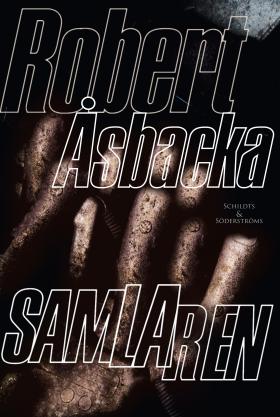
Samlaren
(The Collector)
by Robert Åsbacka
reviewed by Željka Černok
‘I have to stop writing about this street. There was a murder. Nothing can change that. But I have written about it in four books. Everything's investigated. Solved. I am done.’ This is what the author told me when I asked him about his most recent book The Collector. I went home thinking this is just a book about a murder in his home town, straightforward, detailed, maybe a way for the author to deal with it once and for all. Maybe also a good chance for him to have a crack at the ever popular crime genre. I soon realised that I was wrong.
The Collector starts with one of those subtle but telling scenes so typical of Åsbacka: a child is trying to get hold of something that shimmers at the bottom of a lake. It turns out to be a beer cap, something he collects. He eventually fishes it out, takes it home, then pulls out all of the caps he has collected, folds them and sticks them onto his fingertips. Now, they look like shiny, dangerous fangs. Fangs are what he needs, because for Tom, aged 12, life in his small home town is grim. He lives with his mum and sister whose day-to-day rounds seem very one-dimensional to him and make him wonder if there is more to life than the daily grind and going out at the weekends. His best friend has moved away but the last thing they did together was to throw a bike in the lake. It belonged to the local bully brothers, who now demand cash in compensation. This has become Tom's life: dodging the bullies, visiting different abandoned buildings and factory lots in the hope of finding stuff worth selling that the construction workers have left behind, smoking in the hope that it makes him look tough and cool, stealing sweets in the shops or money from the wallet of his mum's lover. His sister is supposed to move away soon and he will finally have his own room where he can display his collections. When he grows up, he wants a cool and relaxed life. Like his neighbours Bo Englund – known in town as ‘the handsome guy with the cars’ – and Bo’s girlfriend Viola, who is nice to Tom.
This is the story, then, of the life of a lonely boy in a boring little town where everything seems to be posing a threat of some kind. At this point, Åsbacka starts introducing genuine documents from the court hearings and we learn about the ‘real’ narrative: seemingly, all that is left for the reader is to watch it unfold with grim inevitability. There has been a murder and the murderer is Englund. He killed a girl, cut her up and threw the remains in the river. The details are gruesome and a disquieting feeling sets in as the reader doesn’t know how the boy is involved in the whole story. Anything that is mentioned only casually ends up making you scared. We learn from the documents that the murderer had a nail fetish. Later on we find out that Tom´s sister has had a secret penfriend who likes long nails on a woman. As the story continues Tom will tell us of his sister´s nails getting longer and of her hanging out with Englund and his friends. Will his sister be the victim? At another point Tom heard that tough guys carry a comb with a sharp metal handle in their pocket because they can use them in fights.
And then, how precisely, how impressively Åsbacka ties it all together: towards the end of the book, Tom gets into yet another fight and uses the comb for just that purpose. The transcribed court hearings grow unreal and frightening, as more and more horrible details about the murder are revealed, but just as horrible is our sense of Tom´s life with its very real and palpable atmosphere of darkness, of being trapped. In later scenes, we see that the adult Tom is reading all about the murder in the library and wondering if he has something like that in him as well. What differentiates him, the child collector, from the murderer? How settled is his life now and has he escaped this darkness forever?
This murder has obviously been a kind of obsession for the author, who has referred to it, one way or another, in several previous books. Always, something lurks in the background of ordinary life in Åsbacka’s small town. There is always a lonely child who drifts and at one point realises the scale of the horrors happening in his own street. Still, this murder was never the focus of his other books. Rather, it might be said that Åsbacka´s main topic has always been little people who find art to enrich their lives. In Fallstudie (Case History), we follow two characters as they collect scrap metal to build a modern sculpture for an exhibition at an arts centre. Their dialogues may well be hilarious, but they are still very real people trying to get to grips with life, trying to find their place and fit in. The same can be said for Kring torget i Skoghall (Around the Square in Skoghall) where we observe a man who transforms a fast-food van into a gourmet restaurant and finds poetry in food. In the masterpiece Orgelbyggaren (The Organ Builder) we follow an old man to his slow death, as he unpicks his life and finds that glimmers of true beauty are all around him and that trusting people and letting them into your life can be safe.
The Collector is a darker book, more scaled down. But even though the focus is narrower, Åsbacka has once again written a book about life. Because that is what good writers always do.

Samlaren
Schildts & Söderströms, 2012. 192 pages.
